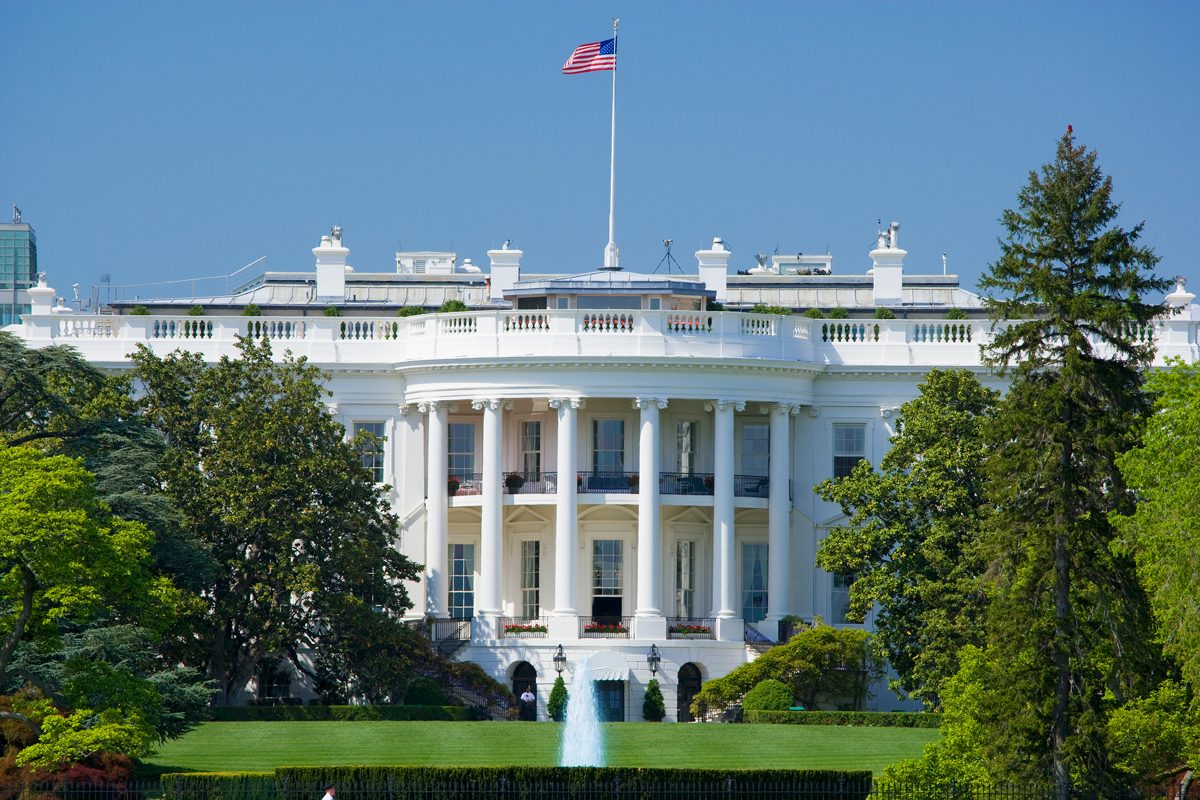It's one of the most famous houses in the world, thanks in part to its striking color

Here’s Why the White House Is White

The White House: three words that bring the same image to mind for every American (and many citizens of other countries as well!). We picture a stately Neo-Classical building, snowy-white and crowned with the Stars and Stripes. It’s true that the moniker of the president’s home is both a name and a descriptor, but what most people don’t know (and maybe haven’t even wondered about) is why the White House is, well … white and what even fewer know is that it was originally built with a different color—and name—in mind. Read on to learn more about this history, White House facts and why the White House is white.
Get Reader’s Digest’s Read Up newsletter for more history, humor, cleaning, travel, tech and fun facts all week long.
When was the White House built?
Before we delve into the answer to why the White House is white, first, a bit of background history. In 1791, George Washington selected the site where the White House would be built. A design by Irish-born architect James Hoban was selected, and the cornerstone for the forthcoming President’s House was laid in 1792. It is thought that Hoban was likely inspired by architectural details from various European mansions. The main facade of the White House resembles the former Duke of Leinster’s mansion in Dublin. Second President John Adams, along with his wife Abigail, were the first presidential family to occupy the still-unfinished building in 1800.
What color was the White House before it was white?
The exterior of the White House was constructed using sandstone from the Aquia Creek quarries in Virginia, so it was originally light gray in color. Six years into construction, in 1798—when the outer walls were finally finished—a lime-based whitewash was applied to the outside to weatherproof the house. By the time Adams moved in, the White House was already being colloquially referred to as such.
While we’re on the subject, let’s clear up a persistent myth. During the War of 1812, British soldiers set fire to what was the home, which, at the time, was known as the President’s Palace, the President’s House, or the Executive Mansion, completely gutting the inside. You might have heard that the building was painted white to cover up the scorch marks from that 1814 attack, but that famous white color actually predates the fire damage.
So does the “White House” nickname. As early as 1812, Congressman Abijah Bigelow wrote in a letter to a colleague, “There is much trouble at the White House, as we call it, I mean the President’s.” (The trouble he referred to was the impending war with Great Britain.)
Why is the White House white?

The lime-based whitewash applied to the exterior of the White House in 1798 prevented water from being absorbed into the soft, permeable and porous sandstone, then freezing and cracking during the cold D.C. winter. The whitewash was continually refreshed in order to keep the house protected from the weather.
The President’s House continued to evolve over the years. Hoban rebuilt the house after the 1814 fire, and it was re-whitewashed and ready when James Monroe, our nation’s fifth president, moved into the building in 1817. The following year, the President’s House was covered with white lead paint, which lasted longer than whitewash. The additions of the South and North Porticos followed in the 1820s under Monroe and Andrew Jackson, respectively. Many other renovations have been carried out on the building since, from President Truman’s structural renovations in the 1950s, to the addition of both indoor and outdoor swimming pools (Franklin Delano Roosevelt and Gerald Ford, respectively).
However, the biggest changes came from President Theodore Roosevelt. When Roosevelt became president in 1901, he installed electric lights, rebuilt the East Terrace and constructed the building that would later become the West Wing. He also officially dubbed the presidential residence the White House. Nearly every U.S. state had an “executive mansion” for its governor; by officially naming it the “White House,” Roosevelt believed that the building would be immediately recognizable as the residence of the President of the United States.
The White House gets a touch-up most years; full coats are usually applied every few years. Each full coat requires about 570 gallons of specialty German-made paint (the 2019 paint job was revealed to be completed in Duron’s “Whisper White” shade), which is designed to preserve historic buildings and can cost up to $150 per gallon.
Sources:
- National Parks Service. “The White House”
- History.com: “This Day In History: August 24th, 1814: British Troops Set Fire to the White House”
- WhiteHouse.gov: “The White House Building”
- The White House Historical Association: “Why is the White House white?”
- FOX Business: “White House’s new paint job: Color, cost, and other fun facts”






















